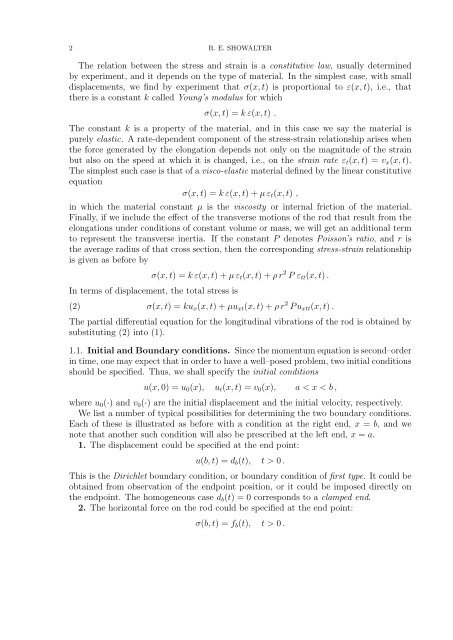THE WAVE EQUATION 1. Longitudinal Vibrations We describe the ...
THE WAVE EQUATION 1. Longitudinal Vibrations We describe the ...
THE WAVE EQUATION 1. Longitudinal Vibrations We describe the ...
You also want an ePaper? Increase the reach of your titles
YUMPU automatically turns print PDFs into web optimized ePapers that Google loves.
2 R. E. SHOWALTERThe relation between <strong>the</strong> stress and strain is a constitutive law, usually determinedby experiment, and it depends on <strong>the</strong> type of material. In <strong>the</strong> simplest case, with smalldisplacements, we find by experiment that σ(x, t) is proportional to ε(x, t), i.e., that<strong>the</strong>re is a constant k called Young’s modulus for whichσ(x, t) = k ε(x, t) .The constant k is a property of <strong>the</strong> material, and in this case we say <strong>the</strong> material ispurely elastic. A rate-dependent component of <strong>the</strong> stress-strain relationship arises when<strong>the</strong> force generated by <strong>the</strong> elongation depends not only on <strong>the</strong> magnitude of <strong>the</strong> strainbut also on <strong>the</strong> speed at which it is changed, i.e., on <strong>the</strong> strain rate ε t (x, t) = v x (x, t).The simplest such case is that of a visco-elastic material defined by <strong>the</strong> linear constitutiveequationσ(x, t) = k ε(x, t) + µ ε t (x, t) ,in which <strong>the</strong> material constant µ is <strong>the</strong> viscosity or internal friction of <strong>the</strong> material.Finally, if we include <strong>the</strong> effect of <strong>the</strong> transverse motions of <strong>the</strong> rod that result from <strong>the</strong>elongations under conditions of constant volume or mass, we will get an additional termto represent <strong>the</strong> transverse inertia. If <strong>the</strong> constant P denotes Poisson’s ratio, and r is<strong>the</strong> average radius of that cross section, <strong>the</strong>n <strong>the</strong> corresponding stress-strain relationshipis given as before byσ(x, t) = k ε(x, t) + µ ε t (x, t) + ρ r 2 P ε tt (x, t) .In terms of displacement, <strong>the</strong> total stress is(2) σ(x, t) = ku x (x, t) + µu xt (x, t) + ρ r 2 P u xtt (x, t) .The partial differential equation for <strong>the</strong> longitudinal vibrations of <strong>the</strong> rod is obtained bysubstituting (2) into (1).<strong>1.</strong><strong>1.</strong> Initial and Boundary conditions. Since <strong>the</strong> momentum equation is second–orderin time, one may expect that in order to have a well–posed problem, two initial conditionsshould be specified. Thus, we shall specify <strong>the</strong> initial conditionsu(x, 0) = u 0 (x), u t (x, t) = v 0 (x), a < x < b ,where u 0 (·) and v 0 (·) are <strong>the</strong> initial displacement and <strong>the</strong> initial velocity, respectively.<strong>We</strong> list a number of typical possibilities for determining <strong>the</strong> two boundary conditions.Each of <strong>the</strong>se is illustrated as before with a condition at <strong>the</strong> right end, x = b, and wenote that ano<strong>the</strong>r such condition will also be prescribed at <strong>the</strong> left end, x = a.<strong>1.</strong> The displacement could be specified at <strong>the</strong> end point:u(b, t) = d b (t), t > 0 .This is <strong>the</strong> Dirichlet boundary condition, or boundary condition of first type. It could beobtained from observation of <strong>the</strong> endpoint position, or it could be imposed directly on<strong>the</strong> endpoint. The homogeneous case d b (t) = 0 corresponds to a clamped end.2. The horizontal force on <strong>the</strong> rod could be specified at <strong>the</strong> end point:σ(b, t) = f b (t), t > 0 .
















